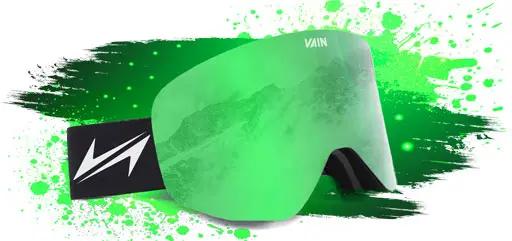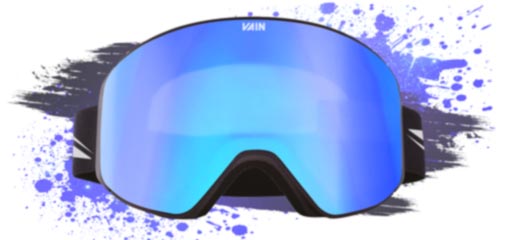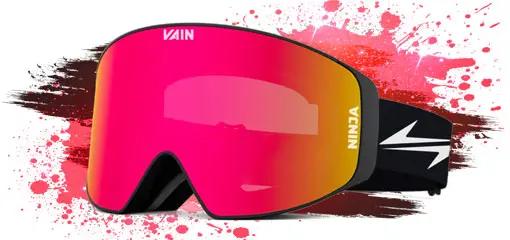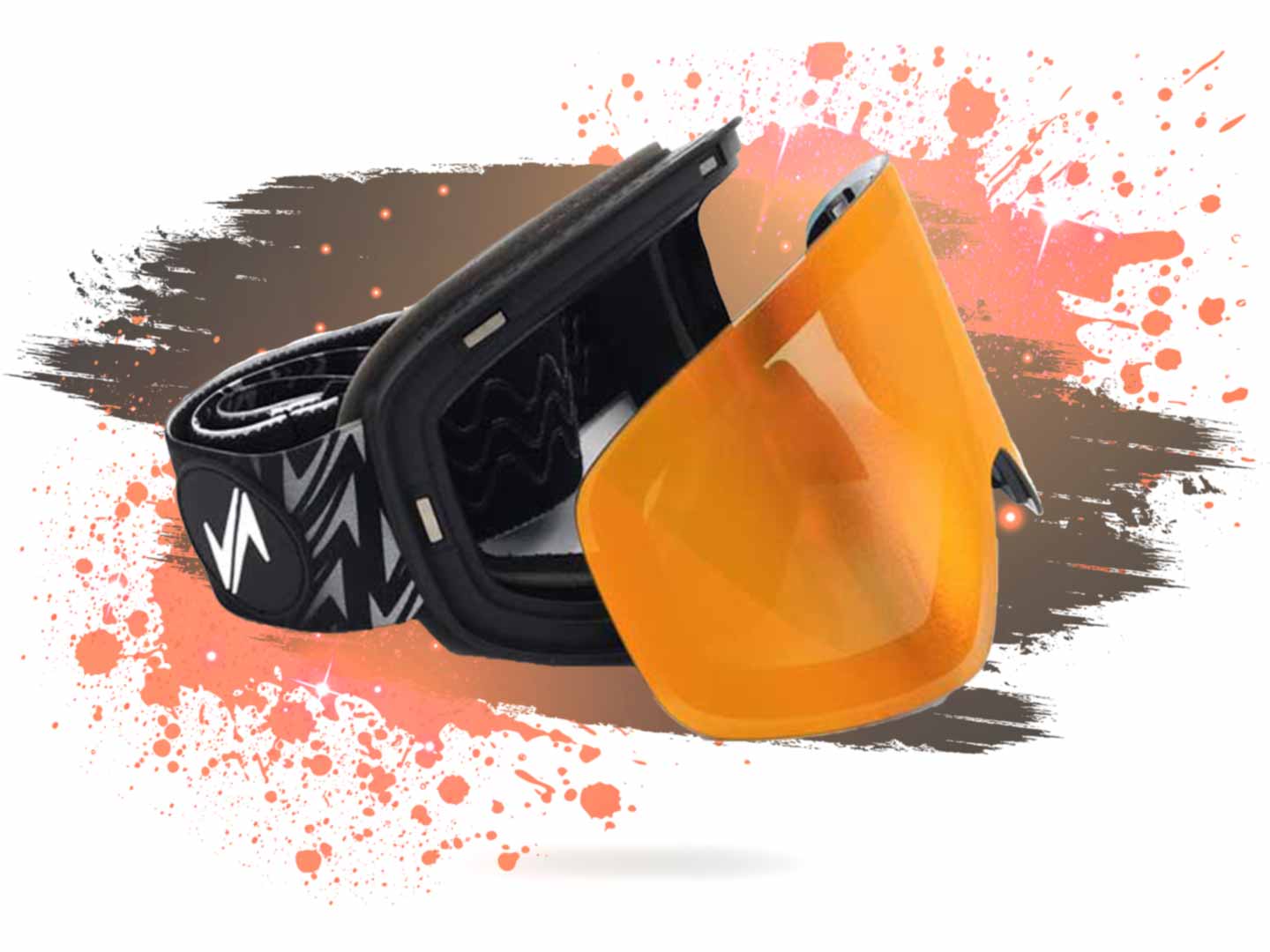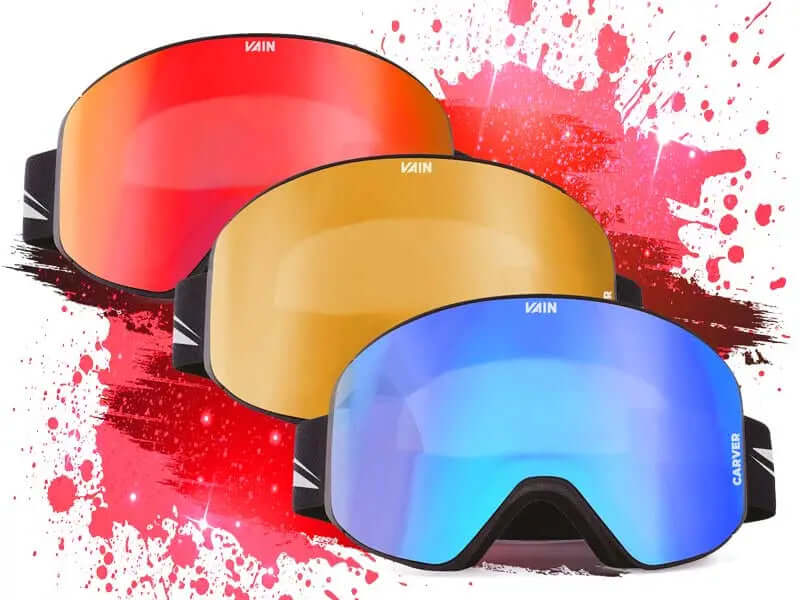How to choose the best ski goggles & snowboard goggles in 2022
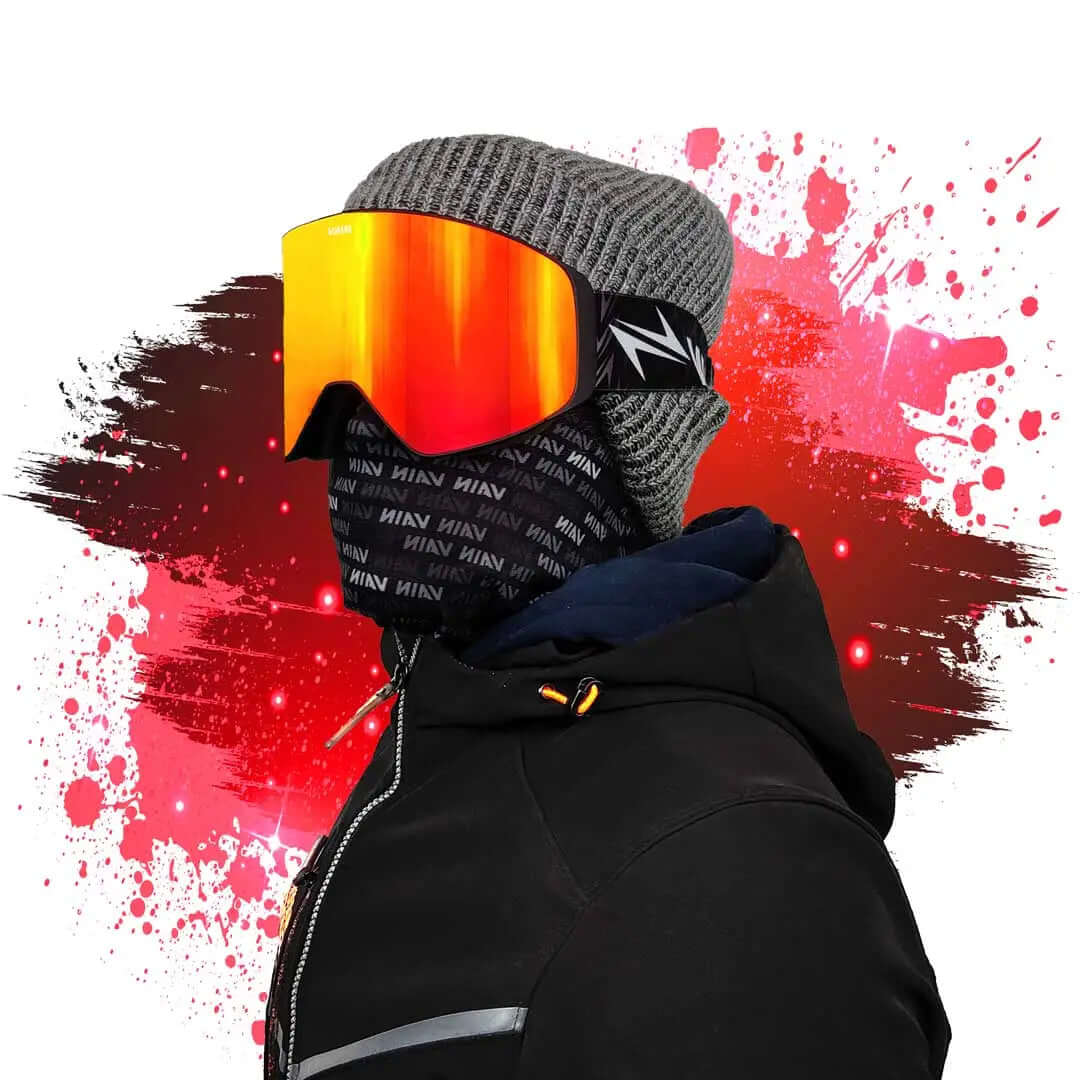
When it comes to winter sports, there is no piece of ski gear more important than your ski goggles. In this blog post, we'll help you choose the best ski goggles for your needs. We'll cover everything from fitting to lens type. So that you can hit the slopes with maximum confidence with your favorite goggles.
In this blog we will cover the next topics:
To keep this thread readable, we describe the subjects in headlines. More in-depth blogs linked at the end of every subject. Have fun reading!

Why do you need a ski goggle?
A lot of first-time skiers or snowboarders ask why they need a goggle in their ski equipment. The answer is simple – because the snow reflects very bright light. These bright conditions can cause a lot of glare, which can be very dangerous. It can also be very difficult to see where you're going.
Wearing a goggle will protect your eyes from the sun and the glare, and will also help you see better. it's by far the most important ski equipment.

Which Ski goggle do I need and what do I look for?
This topic is quite personal as everyone uses their goggle different. You can use snow goggles for learning to ski & snowboard. Or for professional use like freestyle halfpipe snowboarding. Besides that, people prefer different features for the goggles. We’ll go deeper into the features in the goggle type guide.
Let’s get into the little bit less personal part of choosing your snowboard goggles. There are a few things you need to look for when choosing a goggle:
-
The first is fit. You want a goggle that will fit comfortable on your face, and that won't fall off easy.
-
The next thing to look for is lens type. There are a few different types of lenses, and each has its own advantages and disadvantages. You'll need to decide which is best for you.
-
As third you will have to decide the preferred features for your snowboard goggle.
-
Finally, you'll need to decide on a size. Goggles come in a variety of sizes, so you'll need to choose one that's comfortable for you.
What is the best ski or snowboard goggle for me?
There is no single "best" goggle for everyone. The best option is different for everyone. For example, someone that only enjoys ski touring wont need the features of a professional halfpipe snowboarder. But with the tips above and reading this guide you’ll be sure to find your best goggle.
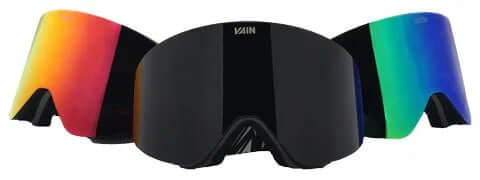
Ski goggle type guide
A good pair of premium goggles is essential for enjoying a day out on the slopes. But with so many different types and brands on the market, it can be hard to know which ones are right for you. This guide will help you understand the different types of goggles. And how to choose the right pair for your needs.
There are three main types of snowboard goggles: frameless goggle, semi-frameless, and framed snow goggle. Frameless ski goggles are the lightest and most comfortable to wear. But they don’t offer as much protection from the cold and wind as the other types. Semi-frameless goggles are a good compromise between weight and protection. And they usually have lens vents to help prevent fogging. Framed snowboard goggles are the heaviest and most protective. But they can be more uncomfortable to wear.
Features
There are dozens of features available in the ski and snow goggles market. We’ll describe the most common and valuable features available!

Air vents ventilation - ski goggles ventilation – keeping your lens clear
You can count on all goggles to have a ventilation system. Some are working very well and others, not so much. Good ventilation is crucial to keeping your lenses fog free. If there is enough airflow between your face and your lense. It helps to keep your lense from steaming up and keeps your vision clear. Make sure the ventilation in your goggles work well together with the ventilation in your helmet. So you can keep your airflow going.

Different lens change system and how they work
Who wouldn’t be frustrated by the typical scenario. You arrive at the parking lot, look up to the sky and see no clouds whatsoever. The sun is shining, a textbook example of a bluebird day—time to break out the dark lens for your goggles. But weather does what it wants, drops the temperatures and brings on the clouds after a couple of laps.
Renowned brands took the example to heart and came up with smart interchangeable lenses systems. These systems are particularly easy to use, and you can get the job done in a few seconds. The changes are achieved in whatever weather and at any time you feel the need for it.
Interchangeable lenses systems available:
Each of the systems had advantages and disadvantages, we’ll explain each one of them.
Magnetic exchangeable lenses are by far the best option for ski goggles.
Not only are they easy in use, they don’t suffer from fatigue. With a good quality magnetic lock, the effect and grip are almost permanent. They can last for 10 years easy, while plastic click, lock or snap systems from plastic break easy. Plastic systems are fragile in cold conditions. You might break them on your first skiing trip. Magnets will not fatigue like plastic and will ensure a good grip on the lens for its lifetime. Besides fatigue, it is also impossible to break or connect the magnetic lens system wrong. The magnets will automatically place the lens in its position.
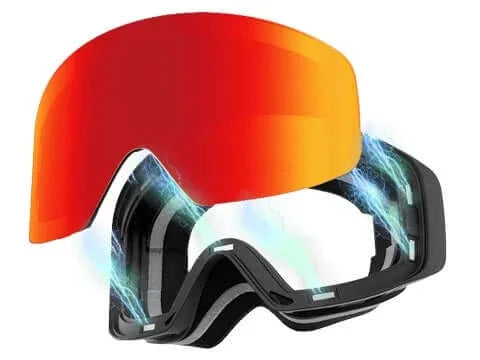
And let’s be fair, isn’t a magnetic exchangeable lens the biggest goggle flex? It is by far the most satisfying way to change the lens on your goggle! If you are intersted in magnetic snowboard goggles, check out our ski goggle collection!
Clip lock systems are the second-best option
The system locks the lens in place and has a good grip which doesn’t come of easy. Downside on this system is that when the system breaks, that you will have to buy a whole new goggle.

Click and snap systems are a cheap alternative
The systems are cheaper than magnets and aren’t as easy to swap. They are the most subject to plastic fatigue which will decrease the lens grip over time. There might even come gaps between the lens and frame. Which is devastating as the main ventilation won’t work as intended.

Magnetic face mask systems
You might have never heard of this. But there are magnetic face mask systems available for ski goggles. A great example are our Vizer ninja ski goggles. The goggle has additional magnets on the bottom side. It functions so that a counter magnetic part can snap onto it. This counter part can be fit into your buff, gaiter, face mask or neck warmer. You can then snap your mask in place.

The biggest benefit is that your mask will always be in the perfect position. So that ventilation keeps working. Besides that it saves a lot of time because you don’t have to struggle to keep it in place. And to be real, a magnetic mask is a huge flex.
Price guide
Prices of ski & snowboard goggles are ranging broadly. Which is explained by the number of features that are available. If you want exotic features and a goggle tailored to the highest needs, you will be sure to buy more expensive ski goggles. On the other hand, a minimalistic goggle can work for you if you don’t care a lot.
How to get the best ski goggle for your money?
Determine what features are relevant for you and which are not. If you know exactly what you want, you can look for the best price.
Price tip:
Do not only look at the bigger brands, small brands deliver superior quality snow goggles at a fair and lower price. You won’t pay a lot for the brand name and save a quick buck. Big companies often put their own profits over their customers needs and decide for the masses. A niche supplier might have the perfect ski goggle for half the price.
Service quality tip:
Look at the reviews and nature of a goggle supplier. Some companies excel in customer service and will do anything to satisfy you. Your better of with those companies when something goes wrong or you experience production defects.

Ski goggles vs visor
There are a few different types of ski goggles, each with its own advantages and disadvantages. One type of goggle is the visor. Visors have a few advantages. They're lightweight and have a large field of view. They're also less likely to fog up. However, they're not as durable as other types of winter goggles. The other option is a helmet and goggle combination which is more flexible and often cheaper. It is also the best option for high performance use. We will sum the differences and pros & cons below, to ultimately decide which is the better option!
Pro’s & Cons for Visor helmets
| Pros | Cons |
| All-in-one package | High prices |
| The best head protection | Limited choice |
| Stylish | Cold wind gusting through |
| Easy care | Bulky look |
| Easy visor slide up | Not made for performance |
| Convenient over the glasses (OTG) |
Conclusion: When to go for a visor
If you go for a fun skiing trip and care more about your fashion than the actual snow sports. Then the visor is an excellent pick. It’s an easy to care for and practical helmet/visor. Although it lacks performance for those who really want to hit the slopes hard.
Pros & cons for ski goggle and helmet combination
| Pros | Cons |
| Unlimited combinations | Seperate storage and handling |
| Better fit to your needs | Helmet and goggle have to fit together |
| Relatively cheaper | |
| Great protection | |
| Way more features available | |
| Ability to use seperately |
Conclusion: When to go for a ski goggle and helmet combination
If you want to hit the slopes hard and have the best of the best. Then yes, the goggle and helmet combination offer the best features. Besides that, it is often a lot cheaper than a visor helmet. If you often don’t use your helmet the goggle is the logic choice.

Ski goggles or Visor: Which one to choose?
Now, all that remains is to choose one. Is the visor helmet or a traditional one a good option for you? The simple answer is that it all depends on your preferences and likings. If you desire comfort and a hassle-free experience while skiing. And you do not compromise on the protection, go with a visor helmet.
But if you like to ski sometimes without your helmet on, or you have a lower budget, you can go with a helmet and snow goggles. Both of them work great without creating difficulties. But due to the latest innovation, visor helmets are really easy to handle and use.
Fit and size guide

How to find the perfect fit for your ski and snowboard goggles
The main function of your Ski and Snowboard goggles is to protect your eyes from snow and moisture during snow sports. As well as from branches and other objects.
Only if your goggles are a proper fit for your face, it will offer you the necessary comfort and protection. Choosing the right frame is the most important criterion in your purchase decision. Manufacturers now offer a wide range of fits, and we’ll explain the differences to consider below.
Small Fit
The small fit of ski and snowboard goggles is usually made for children, youth or for people with a rather small head and face. The small goggle may pose a problem when used with a helmet. As the small frame size might cause gaps between helmet and goggle. The small fit has a standard nose bridge shape.
Medium Fit
Medium fit frame size snow goggles will fit most people with medium sized heads and faces. They would also be the ones that you will have the least issue with finding a well-matching helmet. The medium frame size fit has a standard nose bridge shape.
Large/oversized fit
One of the primary benefits of the large frame goggles and oversize ski goggles is that you have more lens space and a much larger field of view. That means you will see more horizontal as well as vertical. This can be an important feature for freestyle and freeride skiers. Or people simply in need of a more peripheral view. This kind of frame size is used by people who need to wear prescription glasses while skiing and snowboarding. And still want the comfort of snow goggles. Although you should keep in mind that oversized frame size might be hard to find. And might not fit well with helmets.
Over the glasses fit (OTG)
This frame size is designed especially for who is not willing to give up his or her prescription glasses to wear snow goggles. and who wants to enjoy the best of both worlds. It means that the frame design is thick enough to hold its lenses far enough from the face. Which provides enough space for glasses and air flow. It is still pretty difficult to find a fit that will not rub and scratch your face.
Women’s Fit
Women’s Fit frames are not very different from the ones in Medium Sized goggles. They vary in more feminine colors and patterns, and fit narrower faces.
Asian Fit
Asian fit is what you get when you take care to accommodate for specific facial shape. These frames are adapted for people with higher cheekbones and a low nose bridge when it comes to their face.

Ski goggle strap & padding
Additionally, to the fit types, you have to look at the frame padding and strap types.
All snow oggles will come with a strap. It is a user-adjustable and adjustable strap that has a hook or buckle for adjusting the length. It is essential that the hook or buckle also feels comfy while wearing a cap or a bandana. The strap varies in sizes and generally wider straps tend to hold better. Some straps carry a thin line of silicone on the inner side to stop the strap from moving on your helmet.
The material which is touching your face is the padding of the snow goggles. It is an important feature since it sits directly on your face. It can come in a single layer or up to 3 layers of foam.
The padding can increase the wearing comfort by adding a soft porous layer. Which can contour to the facial shape, and a thin layer of fleece which feels smooth and comfortable on your skin. With more layers, the air circulation in the snow goggles improves. Thereby helping to reduce fogging and sweating
Frame flexibility
Additional to strap and padding the frame flexibility is of great importance. It determines if the frame can adjust to your head curvature. If it’s not flexible enough your snow goggles will leave pressure points on your face. These will at first be not that bad, but after a week of skiing they can become a real pain. A good flexibility prevents this by adjusting to your face shape and a more even pressure distribution.

Snow goggle fit problems and solutions
If you find any problems with your goggles, try to locate the area causing the discomfort. Here are some common pressure points and how to prevent them:
PRESSURE ON THE OUTER EYE SOCKET?
The goggle is too narrow, find a model with a wider frame.
PINCHING ON THE BRIDGE OF YOUR NOSE?
Tighten the strap in order to secure the goggles higher on your face. If that doesn't help, try a goggle with a different bridge contour.
GAP ON THE BRIDGE OF YOUR NOSE?
Loosen the strap and position the snow goggles lower down your face. If you're still having trouble, try a goggle with a larger bridge.
PINCHING ON THE TEMPLE?
Try loosening the strap a little to relieve the tension or try a wider pair of snow goggles.
More information needed about fit & size guide?
If you want a more in-depth guide on goggles size en fit guide. We recommend reading our complete ski goggles fit & size guide.

Helmet guide
Ski goggles come in a variety of sizes, and so do helmets. The key to finding the perfect set is not as hard as it may seem. It all comes down to the width and curvature of the helmet and goggle. We’ll explain this to you.
Ski helmet and goggle compatibility: How to find a perfect fit
To make sure that both your snow goggles and helmet function as designed to do. To protect you and feel comfortable, you have to find a good fit. By good fit we mean that there should be little space between your snow goggles and your helmet. It is recommended to leave a little space on top of the goggle to keep ventilation possible. It can happen that you have a gap on your forehead or on the sides of your face. These gaps can result in frost bites or sunburns on the exposed skin.
Manufacturers design their helmets and snow goggles to be compatible or even to have a compatible ventilation. So the airflow system works through the frame of the snow goggles into the ventilation system of the helmet. The only way to ensure that your goggles and helmet fit seamless, is to try it on your own head. Also, after you put your snow goggles and helmet on make sure that the helmet isn’t pushing down on the frame. The best way to avoid pinching on your ski goggles is to take your time to get a good fit. And don’t be afraid to try a few different combos.
Strap adjustability
Another part to take in consideration is the strap adjustability of the goggle. They should be able to extend to fit over the helmet. In most cases the snow goggles equipped with an adjustable strap.

Strap anti-slip rows
Another aspect to keep in mind is the anti-slip function of the goggle strap. Most ski goggles have a silicone anti-slip layer on their strap. To ensure a steady placement, we recommend at least 3 rows of silicone straps. Silicone will work even better when it is applied in a wave pattern.
What also helps is to have a goggle strap fixture on the back of the helmet.
Helmet combination problems and solutions
Sometimes the combination isn’t fitting well and we name a few common reasons why this happens.
Ski goggle is pressed down on your nose.
Your helmet is too big and hangs too far over your forehead. There are two solutions to this problem. Either get a better fitting helmet or get a flatter goggle frame.
Ski goggle is floating in between the helmet
This is due to the combination of goggle having a too wide frame and the helm having a narrow opening. Solution would be to swap either of the two to a better fitting option.
More information needed about helmet compatibility?
If you want a more in-depth guide on snow goggles and helmet compatibility. We recommend reading our complete ski goggles and helmet compatibility guide.

Over the glasses (OTG) Guide for ski goggles
If you’re a spectacle wearer and you rather don’t use contact lenses, then the options are limited. There are three practical options: Wear a goggle over the glasses, prescription inserts and using a helmet with visor. We will describe each of the options and its advantages.
Ski goggle over the glasses
When you want to use a goggles over your glasses the right decision is complicated. First of all, we have to make clear what the size of your glasses are. If you have big glasses, it can be hard to find a proper fitted ski goggles. But when you have a small frame, this becomes a lot easier.
To make this a bit easier we give an indication of the goggle size per glasses frame width and size:
| Glasses width | Glasses size | Goggle size | Vizer Goggle |
| 130 mm | Medium | Medium | Slopester |
| 135 mm | Medium | Large | Carver & Ninja |
| 140 mm | Medium | Oversized | - |
| 145 mm | Medium | Visor Helmet | - |

Ski goggles prescription optical inserts
Some ski goggles can accommodate a prescription optical insert, which can be glazed to a specific prescription. These inserts fit into the goggle frame. And allow glasses wearers to have great optics without wearing their own glasses under the goggles. If you are interested in a compatible goggle. We recommend to look for a company that can support both the goggle and the insert for you.
Visor in combination with glasses
An alternative option to ski goggles is using a ski helmet with visor. The visors are bigger so that it won’t get in the way for your glasses. It can be hard to find a OTG goggle, going for the visor option might safe a lot of time. If you want to read more about the comparison of snow goggle + ski helmet vs visor, read our thread.
More information needed about OTG?
If you want to read a more in-depth guide for wearing prescription glasses with goggles and alternatives. We recommend reading our OTG ski goggles guide.

Lens Guide
When choosing a pair of ski goggles, you should also consider the lens type. If it comes down to lenses there are endless options for functionality and colors. We’ll explain the most important aspects of lenses in the following order:
Lens forms: cylindrical spherical or torical – what is the difference?
Not every lens is the same. In general, ski goggles can be classified into three lens shape types: spherical, cylindrical, and torical. Cylindrical and toric lenses are both made out of a cylindrical lens. The spherical lens is made out of a globe form.

Cylindrical lens shape
Cylindrical lenses are bent on the vertical axis and flat on the horizontal axis. Because of this construction, it will not offer you much of a peripheral view. Most lenses with cylindrival shape give a huge range of view horizontal. And they do not absorb as much rays from the sun as the spherical ones. The upside is the lower price range of these snow goggles.
Cylindrical lens technology is the best option available as there is a vertical curve. Vision deformations are less common than with globe formed lenses.

Spherical lens shape
With spherical lenses, you will get a better field of view as they curve on both the horizontal as well as on the vertical axis. The one downside of this shape is the higher price point of those lenses. But these are justified by many pros, which you will appreciate once you are on the mountain. These include getting a more peripheral vision feel and seeing what is below, above and next to you. The curve of the lens is similar to your eyes and will cause less distortion. It also allows for more space between your face and the lens which results in more airflow and less fogging. Another advantage of spherical lenses is the ability to distribute and diminish the amount of glare.
The optical quality of the spherical lens is worse than the cylindrical and toric lens shape. Reason for that is that the lens is curved in a globe forme. Distortions of coatings and plastic deformation are much more likely.

Toric lens shape
Toric lenses are a combination of the spherical shape and the cylindrical shape. They are less curved vertical than spherical lenses. But more curved horizontal than cylindrical lenses. This shape has the advantage of very little distortion in the peripheral vision. And allowing an even wider field of vision without the extreme bulbous shape of spherical lenses.
The optical quality of the toric lens is better than the spherical lens are worse than the cylindrical lens shape. Reason for that is the angle of the deformation, for cylindrical lenses this is vertical. For toric lenses this is diagonal, which can cause distortions.
Single- and double-layer lenses
Both single and double layer lenses are available, but one of the two is the better option.
Single layer lenses
Single layer lenses are cheap and therefore applied on most cheap goggles. They will fulfill the most necessary functions if equipped with the correct coatings.
Double layer lenses
Double layer lenses are the best lenses if you want quality. These lenses have a lot of benefits compared to the single layered lenses. There is more room for additional coatings and they are better applicable. Which results in better quality.

The biggest benefit of double layer lenses is the anti-fog function. Due to the higher isolation value, the temperature gap between the inside and outside of the goggle is less. This reduces the fogging-up of the most lenses.
VLT & Applicability
Visible Light Transmittance (VLT) is the amount of light that can get through the lens. The higher the VLT % the more light can get through one lens. We will explain for why VLT is important and how to adjust to the lighting conditions.
Why is VLT important?
The VLT value determines its useability in certain weather conditions. For example a 6% VLT lens won’t let a bright light through, wearing this at night will make you practically blind. While a 64% VLT lens will let a lot of light through and won’t protect you as much against glare and blinding sunlight.
When do I use which ski goggle lens?
Now that you know what VLT means, it’s time to talk about its applicability. A ski goggle lens will always have a VLT value, which determines in which weather condition it can be used best. To make this whole VLT % value a bit easier to understand. We have the European CE categories and its best suited weather condition as follows:
| CE Category |
Best applied weather conditions |
| CE 0 (80-100% VLT) |
Midnight, snowy & cloudy weather |
| CE 1 (43-80% VLT) |
Misty, snowy & cloudy weather |
| CE 2 (18-43% VLT) |
Cloudy, partly cloudy & slightly sunny |
| CE 3 (8-18% VLT) | Partly cloudy & sunny weather |
| CE 4 (3-8% VLT) | Sunny & extremely sunny weather |
If we make the lens CE categories visible in comparison, it would look something like this:

Which color ski goggle lens do I need?
There is no quick answer to this question. These days lenses come in almost every color of the rainbow. The most important lens color is the base lens color. Base lenses are made in a certain color to provide better vision and lighting conditions. The yellow lens for example makes everything look yellow which gives more contrast. The yellow lenses give excellent optics for night skiing. So that you can spot the gaps in the slopes easier.
Pick lenses that can handle the weather conditions
But instead of choosing according to your personal color preferences. You should decide upon the weather conditions. There is more to it than the tint of your lens, you should also pay attention to Visible Light Transmission (VLT). The VLT, a very specific feature, shows you the percentage of light allowed through the lens. (falling somewhere around 0% and 100%) As well as how much contrast there is in your surroundings.
All round lens option
If you are trying to find a lens that has it all, we have bad news for you. Unfortunately, there is no perfect all-rounder which can guarantee you perfect vision under in conditions. If you really had to be forced to go for just one lens, opt for one with the VLT around 20-30%. It will be a compromise that won’t supply full support in extreme conditions but will keep you happy and safe in most cases. We recommend to have at least two lenses in your goggle set.
Photochromic lenses
You might have heard of photochromic lenses, and they are quite useful. These lenses are transparent in situations where there are low light conditions. When the sun starts shining, the photochromic lenses starts to darken. This lens adjusts itself to the weather & lighting conditions. Downside to the photochromic lens is that it can never reach VLT values needed for sunny weather.
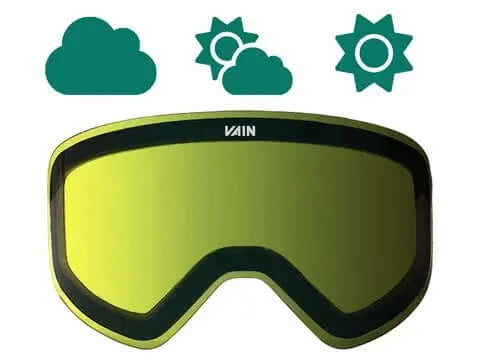
Coatings
An essential addition to the lenses is its coatings. There are coatings for a lot of reasons, we’ll sum up the most convenient ones:
-
Anti-scratch coating: to prevent scratched lenses by giving it more scratch resistance
-
Anti-fog coating: to prevent fogging-up of your lens
-
UV 400 protective coatings: to protect you from harmful uv rays
-
Polarizing coating: to reduce glare
-
Visual appearance coatings: to give a certain color or mirrored lenses

The REVO coating
There are a dozen of different mirror coatings that are used but the REVO coating is the best out there. Most lenses have a REVO coating. The REVO coating is developed by NASA for space shuttles. The coating improves the lens quality. Because the sunlight in space is much more dangerous than on earth, a protective coating was needed. The coating reduces glare by 99% and is therefore very comfortable in use. We use this REVO coating for our ski goggles as well. This ensures the best protection and optical lens quality for our customers!
Another big benefit from the REVO coating is that it can be enhanced to almost any mirror color available. This can be done while containing the best lens quality and lighting conditions. This gives us the ability to create awesome colors like our Crimson, Arctic, Auric and Viridian lenses. If you are looking for high quality lenses or mirrored lenses, go for a REVO coating.

UV Protective coatings
These optic coatings will protect you from harmful and bright sunlight. The coating is made to block the UV rays that are harmful. The rays from 100 up to 300 nanometer are harmful as the eye cannot block them. The rays from 300-380 are only partially blocked, as the human eye can block those themselves. Everything above 380nm is what we see as colors and are not harmful.
More information about lens technology
If you want a more in-depth analysis of the lens technology. We can recommend reading our complete lens guide.
Anti-fog guide
Fog that sticks to your lens might be one of the most annoying events during the winter sports. Well hang on because we’re going to teach you everything we can, so that you never have a fogged-up goggle again.

Why does fog occur in my ski goggle?
The phenomena we call fog, are actually tiny droplets of water sticking to our lens. This happens because water has the natural behavior to stick to flat surfaces. If the amount of water increases the fog intensifies.
How can I prevent fog in my ski goggle?
To prevent fog in your ski goggle, you will have to reduce the amount of moisture inside the goggle. This can be done in many ways and we will make sure you learn every one of them. Additionally, we will give you some tips & tricks to start everyday fresh.
We have a total of 7 solutions to prevent fogging up of your ski goggles:
-
Anti-fog coating
-
Double layered lens
-
Optimal ventilation
-
Triple layer foam
-
Attachable face masks
-
Storing dry
-
Reserve lenses
Additional we have a few tips an tricks that will help you keep them dry:
-
Keep moving
-
Keep ventilating
-
Clean & dry after use
Anti-fog coating
This is the best and most logic solution to your fog problem. A good anti-fog coating ensures that the building up of fog is delayed. The best goggles are equipped with an excellent anti-fog coating. Be sure to buy excellent goggles with an anti-fog coating, otherwise you will regret this.

Double layer lenses
To even further improve the anti-fog coatings effect, a double layered lens is the next best option. An extra layer of air in between the lenses provides a better isolation than a single lens. Due to the isolation, moisture will less likely stick to the lens due to temperature difference.
Optimal ventilation
The third most effective aspect is the ventilation of the snow goggle. If the airflow in the snow goggle is active, moisture won’t have time to stick to the lens and temperature inside will be regulated. This also depends on the ski helmet and ski goggle combination. If the gap between each other is too small, it can block the air-flow.
Triple layer foam padding
This one might be more effective than people think. A good foam padding is able to repel moisture and sweat. The outermost layer is the most important as it touches your face.

Attachable face mask
Correct wearing of a face mask can help drastically. Make sure that you aren’t breathing inside the ski goggle, as this speeds up moisture build-up. A good breathable face mask can help too.
Attributes to store your gear dry
A well stored ski goggle and lenses can give you a clean start. Important here is that you have a dry set at the start of the day.
Additional lenses
What might be the most effective way is having two high quality lenses. Although it is also the most expensive one, having a fresh lens halfway the day can give you a fresh restart. Two lenses give you the option to adjust to the weather better. If you go for two lenses it is recommended to have an all-round 20-30% VLT lens and a 60% VLT lens. This ensures that you keep high quality optics.
Keep moving
While your wearing the ski goggle, it’s best to keep moving as the air-flow is at its best.
Keep ventilating
Do you find yourself standing stil? Keep ventilating by placing your ski goggle on the edge of your helmet. Note that you shouldn’t do this when your helmet is wet.
Clean and dry after use
Simple but effective, at the end of your skiing session. Clean up your goggle, wipe any excess filth off the lens with a microfiber cloth. And store the goggle in a warm and ventilating place so that it can dry up overnight.
Want a more in-depth explanation of anti-fog coatings?
We recommend to read our complete blog about anti-fog and keeping your ski goggles dry.
Tips & Tricks
How to clean your snow goggles:
-
You should not clean your lens with a paper tissue, toilet paper and similar materials. The fibers will scratch it.
-
Always have a special microfiber cloth on hand to clean your lens with on the outside. Never press too hard against the surface.
-
Use additive free water to clean your snow goggles. Don’t add soap or abrasive additives that can scratch and damage coatings.
-
Never touch/wipe the inside of your ski goggle lens. The inside surface of the lens is coated with a special anti-fogging layer. You can easily scratch this layer off by whipping the lens and your lens will fog very quickly.
-
If there is ice on your lens, let this melt first by warming it up. Removing ice may give scratches.
-
Air dry your snow goggles after cleaning.

Ski goggle care:
-
Always store your snow goggles inside a hard case if you are not using them. Heavy skiing/snowboarding equipment can easily break off parts, bend the full frame, tear off padding or scratch/crack the lens.
-
If you need to remove excess water from your inner lens, first place it in a place where it can shake off the excess water. Next, dab very gently at the remaining water spots with a microfiber cleaning cloth.
-
Reapply an anti-fog treatment or coating to old lenses.
Handling:
-
Never lay your ski goggle on its lens surface. A grain of sand can be enough to scratch the lens. Once scratched, it cannot be removed.
-
Store your ski & snowboard goggle in the supplied EVA Hard case and microfiber pouch.
-
Keep your ventilation clear of snow.
-
Don’t store your snow goggles in extreme heat or cold.
Want a more in depth explanation for keeping your goggles safe and clean? Read our: how to clean your ski goggles article.
Questions & Answers
Do I need a nose guard on my ski goggles?
Some manufacturers provide ski goggles with a small guard which is there to protect your nose from UV rays (sun) or snow that can fly around. This topic is somewhat controversial since there are individuals who love it and would not go skiing without it. There are also some who have a rather negative attitude towards this accessory. It makes sense for people who go snowmobiling or ski/snowboard through forests with low and dense branches. Or plan on going for glacial tours in high altitudes.
What do I do when my lens gets scratched?
Once your snow goggle gets a scratch on its lens, there is no way back. You do not necessarily need a completely new pair of ski goggles, but rather a new lense. The best way to prevent your goggles from getting scratched is to take good care of them.
Which exchangeable lens system is the best?
The best option which also has the longest lifetime is the magnetic exchangeable lens system. This system also benefits in an easy and faultless change process. You can’t make a mistake as the connection happens automatically with a magnetic system.
What snow goggle lens do I need?
It depends on when and where you ski or snowboard, but we can bring it down to these key points. A S2 CE category lens with a VLT around 20% is the ideal all-rounder. It can be used in any condition with the least shortcomings.
Although for comfort we advise to get at least 1 additional lens for low light situations. A category S1 CE lens with VLT around 60% would be a perfect combination. You will benefit from this on cloudy, snowy days and misty situations.
Additionally, you could get a third lens for the extreme light conditions. A CE category S3 or S4 lens is recommended with a VLT value between 6% - 10%.
If you are looking for a fairly priced ski goggle set. With 2 lenses, of which a 20% VLT lens and a 64% flat light lens. Click the button below!
How long can ski goggles last?
Depending on how you care for your snow goggles, they can last 10s of years. Check our Tips & Tricks on how to achieve a longer lifetime for your ski and snowboard goggles.
Why are ski goggles so expensive?
This totally depends on what kind of snow goggles you are buying. There are cheap variants that are minimalistic and don’t offer much. On the other side are heavily specialized ski goggles that are tailored to your specific needs. It all depends on what you care about. You can check all the technical features in the feature & price guide.
Ski helmet with or without visor?
Both options are fine, but it comes down to your use and preferences. The visor is easy and convenient in use. If you want to wear prescription glasses while skiing, a visor helmet is great! The helmet with a ski goggle is better able to adjust to your specific needs. To read all the pros and cons of each variant, read our goggle & helmet vs visor tread.
Which ski goggle for mist?
The most convenient ski goggle for mist is one with a lens of CE category S1 that boosts contrast. Yellow & orange base lenses give a good contrast during misty weather. VLT values of 45-95% are recommended.
Which ski goggle for snowy weather?
The best snow goggle for snowy weather has a lens of CE category S1 or S0 and enhances contrast. A yellow lens is best suited for contrast boosting while its snowing. A VLT value of 60-95% would be recommended.
Which ski goggle for sunny weather?
The best ski goggles for sunny weather is one that has a lens with a CE category of S2, S3 or S4 and has a VLT value between 6-30%. Our smoke lens is a good example of a lens suitable for sunny weather.

Which ski goggle for cloudy weather?
The best fit ski goggles for cloudy weather is one that has a lens with CE category S1 or S2. Recommended VLT values would vary between 40-80%
Which ski goggle for bad weather?
The best suited ski goggles for bad weather is one with a flat light lens. A lens that gives a good contrast and has a high VLT value. So that you have a great vision under bad weather circumstances.
Which ski goggle lens is the best?
There is a best lens for every weather condition. The best overall lens had a 20-30% VLT value and has a gray base lens. Additionally, coatings can be applied for even better properties. Necessary coatings could be: anti-fog, UV protective, polarizing and anti-scratch coatings.

What is a flat light lens?
A flat light lens is for snowy weather when there are little light conditions and snow falling down. The weather conditions make it hard to see good, a proper flat light lens will improve your vision. Yellow base lenses are a great option for contrast boosting while snow. A VLT value of 60-95% would be recommended. Check our Daylight lens for a good reference.
How do you change a ski goggle lens?
Depending on the lens change system they are as described below:
-
Magnetic lenses allocate to its position automatically by its magnetic properties
-
Click lenses click in their position by elastic plastic hooks
-
Locked lenses lock in place by its locking mechanism
You might also like:
How to choose the best snow goggle lens color for each weather
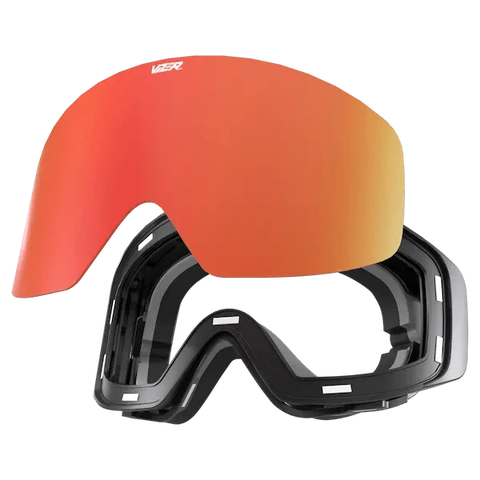
0 comments

